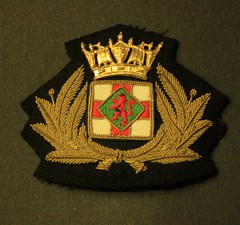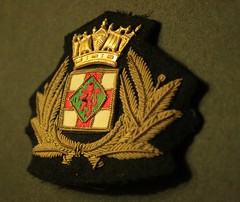Wool backing and wreath of silver thread.
Central device, stamped white metal.
Circa Second World War era.
A fact often overlooked by those interested in convoy history is that each ship that entered or left a port area was piloted by an individual versed in the particulars of the waters surrounding the port; when a ship was straffed by airplane fire, those on the bridge were targeted first with many a casualty being the pilot.
To this day, pilots are still employed and are organized in associations and pilotage authorities much as they have been for the past hundred years. A major pilotage house, such as the Virginia Pilot Association, has about 40 active pilots, who steer a yearly 2000 or more vessels in and out of Hampton Roads. These days, they are fortunate that their launches are motorized, as in years past, the vessels were predominantly powered by sail and oars. Following in the Anglo-American tradition, apprentice pilots live on station, work some seven days a week around the clock, and are subject to U.S. Coast Guard examinations, tests and practical demonstrations. Moreover, to prove their knowledge of the sea about them, apprentices must re-create mariner's charts of Hampton Roads from memory. All of these skills are needed for a knowledgeable and professional group of pilots - all ready at a moment's notice to bring an oil tanker or yacht to port, the former's stopping distance measured in miles. These individual work hard, and without whose dedication to knowing their waterways shipping depends, precious cargoes would remain offshore. In interesting article about pilots on the C&D canal may be found here, View from the Bridge.
Much like Hampton Roads, Liverpool was a major embarkation port and convoy terminal during the Second World War; the city's port and train facilies were key links in the Allied war effort's supply chain, and as such the Germans considered it a major strategic target. Despite the constant barrage of aerial bombings, on average a convoy either entered or left Merseyside each day for the duration of the War. Interestingly enough, the last house destroyed by Luftwaffe bombing was Hitler's half-brother Alois' previous residence at 102 Upper Stanhope Street in Toxteth.
Presented is Mersey Docks and Harbour Board offical's hat badge. This device was worn by both Harbourmasters and pilots in the Liverpool Pilot Service. In the United Kingdom, a Harbourmaster is an appointed position once held exclusively by Navy Officers, they issue local safety information, oversee the maintenance and provision of navigational aids within port areas, co-ordinate maritime emergency response, do vessel inspections and oversee pilotage services. In a large port, such as Liverpool's Merseyside, there is a head Harbormaster assisted by a small staff of assisting officers - during the Second World War, about 20; a priviledge of office is a white-bordered Union Flag with a white central disc bearing the initials "QHM" (or "KHM") beneath the crown, which is flown from the gaff or yardarm either afloat or on land.
The Liverpool Pilot Service has historically been an independent cooperative association, and is now operated and licensed by the Mersey Docks & Harbour Board (MD&HB) the Port of Liverpool authority. Its stations are located at Point Lynas on the North coast of Anglesey and at the Mersey Bar. At its inception up until the 1960s, the Liverpool Pilot Service covered the approaches to all ports around the Eastern Irish Sea from Holyhead in the South, to Barrow in the North, and the East coast of the Isle of Man; now, pilots are employed to guide ships to the River Mersey ports, which include the Liverpool and Birkenhead Docks, the Manchester Ship Canal and Garston. It is worth mentioning that at latter, vessels are handed-over to a once fierce rival: the Manchester Ship Canal Company Pilots.
Mersey Docks, Hat badge, obverse.
Metal and silver wire on wool backing. Metal central device.
Circa Second World War.
In terms of harbor agencies and government boards, this hat badge follows the British standard design of large laurels leaves with a municipal central device. More often than not, the leaves for other agencies are gold bullion - the Mersey Docks wreath is unusual in that respect, but still within "symbolic bounds." The central device is quite interesting being that it is Athena in a throne over Posideon; this hearkens to Liverpool's claim to being the "Athens of the North." Interestingly this same device is not found anywhere in Mersey Docks and Harbour Board Offices building except on the uniform buttons of the Harbourmasters and pilots.

Mersey Docks, Hat badge, obverse.
Metal and silver wire on wool backing. Metal central device.
Circa Second World War.

Mersey Docks, Hat badge, obverse, detail.
Metal and silver wire on wool backing. Metal central device.
Circa Second World War.

Views of the Mersey Docks & Harbour Building
















